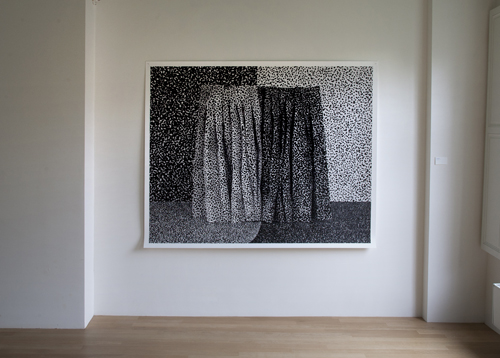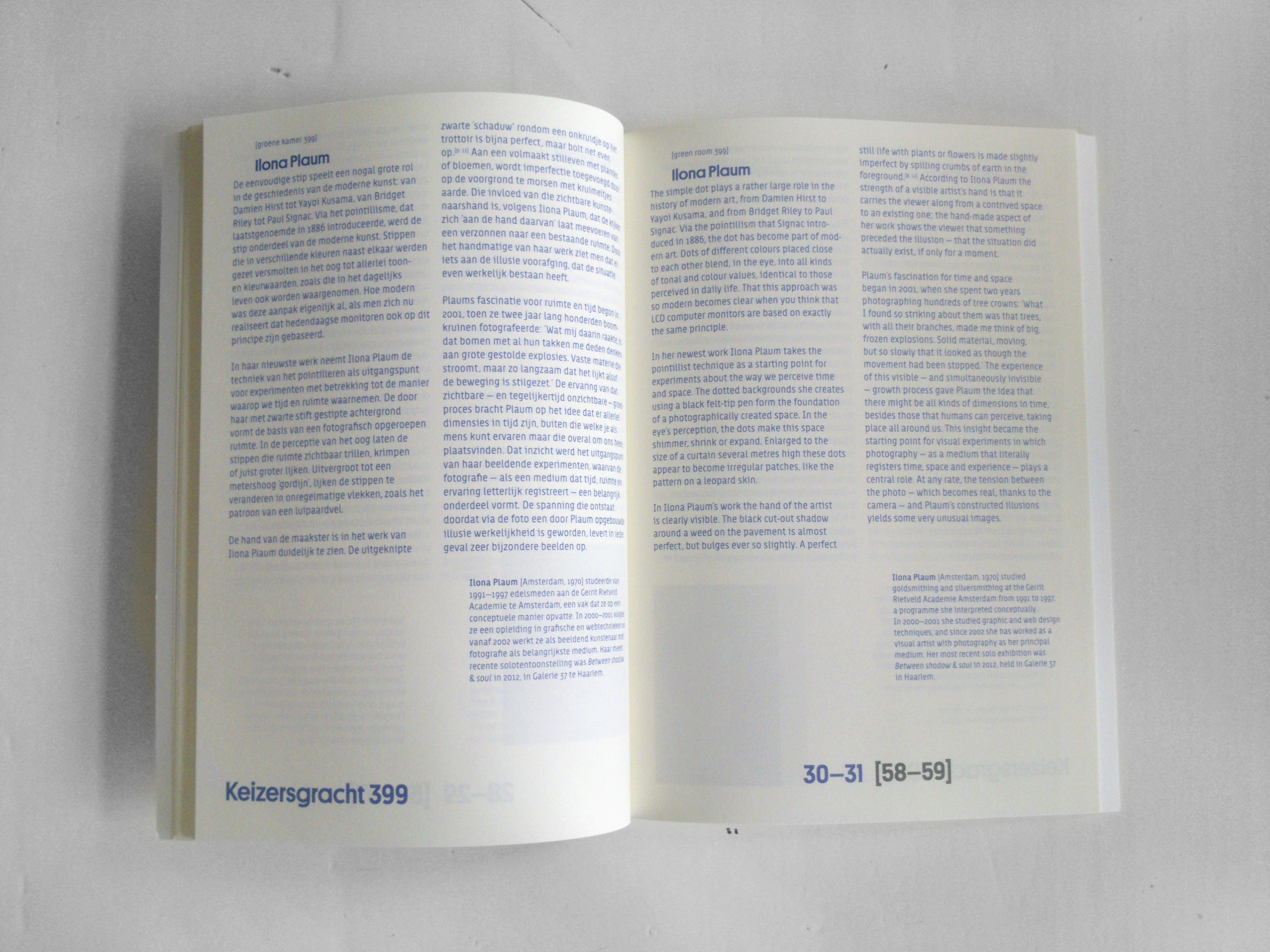The rediscovery of the world
Catalog
Text: Nanda van de BergThe simple dot plays a rather large role in the history of modern art, from Damien Hirst to Yayoi Kusama, and from Bridget Riley to Paul Signac. Via the pointillism that Signac introduced in 1886, the dot has become part of modern art. Dots of different colors placed close to each other blend, in the eye, into all kinds of tonal and colour values, identical to those perceived in daily life. That this approach was so modern becomes clear when you think that LCD computer monitors are based on exactly the same principle.
In her newest work Ilona Plaum takes the pointillist technique as a starting point for experiments about the way we perceive time and space. The dotted backgrounds she creates using a black felt-tip pen form the foundation of a photographically created space. In the eye’s perception, the dots make this shimmer, shrink or expand. Enlarged to the size of a curtain several meters high these dots appear to become irregular patches, like the pattern on leopard skin.
In Ilona Plaum’s work the hand of the artist is clearly visible. The black cut-out shadow around a weed on the pavement is almost perfect, but bulges ever so slightly. A perfect still life with plants or flowers is made slightly imperfect by spilling crumbs of earth in the foreground. According to Ilona Plaum the strength of a visible artist’s hand is that it carries the viewer along from a contrived space to an existing one; the hand-made aspect of her work shows the viewer that something preceded the illusion - that the situation did actually exist, if only for a moment.
Plaum’s fascination for time and space began in 2001, when she spent two years photographing hundreds of tree crowns: ‘What I found so striking about them was that trees, with all their branches, made me think of big, frozen explosions. Solid material, moving, but so slowly that it looked as though the movement had been stopped.’ The experience of this visible - and simultaneously invisible- growth process gave Plaum the idea that there might be all kinds of dimensions in time, besides those that humans can perceive, taking place all around us. This insight became the starting point for visual experiments in which photography - as a medium that literally registers time, space and experience - plays a central role. At any rate, the tension between the photo - which becomes real, thanks to the camera - and Plaum’s constructed illusions yields some very unusual images.
Ilona Plaum (Amsterdam, 1970) studied goldsmithing and silversmithing at the Gerrit Rietveld Academie Amsterdam from 1991 to 1997, a programme she interpreted conceptually.
In 2000-2001 she studied graphic and webdesign techniques, and since 2002 she has worked as a visual artist with photography as her principal medium. Her most recent solo exhibition was ‘Between shadow and soul’ in 2012, held in Galerie 37 in Haarlem.
In 2000-2001 she studied graphic and webdesign techniques, and since 2002 she has worked as a visual artist with photography as her principal medium. Her most recent solo exhibition was ‘Between shadow and soul’ in 2012, held in Galerie 37 in Haarlem.
NL
De eenvoudige stip speelt een nogal grote rol in de geschiedenis van de moderne kunst: van Damien Hirst tot Yayoi Kusama, van Bridget Riley tot Paul Signac. Via het pointillisme, dat laatstgenoemde in 1886 introduceerde, werd de stip onderdeel van de moderne kunst. Stippen die in verschillende kleuren naast elkaar werden gezet versmolten in het oog tot allerlei toon en kleurwaarden, zoals die in het dagelijks leven ook worden waargenomen. Hoe modern was deze aanpak eigenlijk al, als men zich nu realiseert dat hedendaagse monitoren ook op dit principe zijn gebaseerd.
In haar nieuwste werk neemt Ilona Plaum de techniek van het pointilleren als uitgangspunt voor experimenten met betrekking tot de manier waarop we tijd en ruimte waarnemen. De door haar met zwarte stift gestipte achtergrond vormt de basis van een fotografisch opgeroepen ruimte. In de perceptie van het oog laten de stippen die ruimte zichtbaar trillen, krimpen of juist groter lijken. Uitvergroot tot een metershoog ‘gordijn’, lijken de stippen te veranderen in onregelmatige vlekken, zoals het patroon van een luipaardvel.
De hand van de maakster is in het werk van Ilona Plaum duidelijk te zien. De uitgeknipte zwarte ‘schaduw’ rondom een onkruidje op het trottoir is bijna perfect, maar bolt net even op. Aan een volmaakt stilleven met planten of bloemen, wordt imperfectie toegevoegd door op de voorgrond te morsen met kruimeltjes aarde. Die invloed van die zichtbare kunstenaarshand is, volgens Plaum, dat de kijker zich ‘aan de hand daarvan’ laat meevoeren van een verzonnen naar een bestaande ruimte. Door het handmatige van haar werk ziet men dat er iets aan de illusie vooraf ging, dat de situatie even werkelijk bestaan heeft.
Plaums fascinatie voor ruimte en tijd begon in 2001, toen ze twee jaar lang honderden boomkruinen fotografeerde: ‘Wat mij daarin raakte, is dat bomen met al hun takken me deden denken aan grote gestolde explosies. Vaste materie die stoomt, maar zo langzaam dat het lijkt alsof de beweging is stilgezet.‘ De ervaring van dat zichtbare -en tegelijkertijd onzichtbare- groeiproces bracht Plaum op het idee dat er allerlei dimensies in tijd zijn, buiten die welke je als mens kunt ervaren maar die overal om ons heen plaatsvinden. Dat inzicht werd het uitgangspunt van haar beeldende experimenten, waarvan de fotografie -als een medium dat tijd, ruimte en ervaring letterlijk registreert- een belangrijk onderdeel vormt. De spanning die ontstaat doordat via de foto een door Plaum opgebouwde illusie werkelijkheid is geworden, levert in ieder geval zeer bijzondere beelden op.
Ilona Plaum (Amsterdam, 1970) studeerde van 1991-1997 edelsmeden aan de Gerrit Rietveld Academie te Amsterdam, een vak dat ze op een conceptuele manier opvatte. In 2000-2001 volgde ze een opleiding in grafische en webtechnieken en vanaf 2002 werkt ze als beeldend kunstenaar met fotografie als belangrijkste medium. Haar meest recente solotentoonstelling was Between ‘Shadow & Soul’ in 2012, in Galerie 37 te Haarlem.


